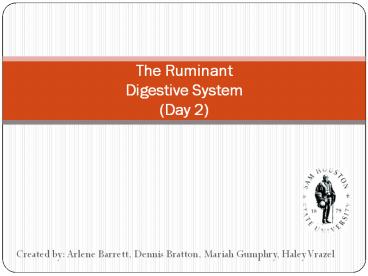The Ruminant Digestive System (Day 2) - PowerPoint PPT Presentation
Title:
The Ruminant Digestive System (Day 2)
Description:
The Ruminant Digestive System (Day 2) Created by: Arlene Barrett, Dennis Bratton, Mariah Gumphry, Haley Vrazel Objectives Define the functions of ruminant animals. – PowerPoint PPT presentation
Number of Views:314
Avg rating:3.0/5.0
Title: The Ruminant Digestive System (Day 2)
1
The Ruminant Digestive System (Day 2)
Created by Arlene Barrett, Dennis Bratton,
Mariah Gumphry, Haley Vrazel
2
Objectives
- Define the functions of ruminant animals.
- Analyze ruminant digestive system.
- Analyze the first two components of the digestive
system of ruminant animals.
3
Ruminant Digestive Systems
- Functions of the digestive system of animals
include - ingestion (eating)
- chewing (mastication)
- swallowing (deglutition)
- absorption of nutrients
- elimination of solid wastes (defecation)
4
Ruminant Digestive Systems
- The digestive system changes food nutrients into
compounds that are easily absorbed into the
bloodstream.
5
Ruminant Digestive Systems
- Ruminants are those animals that contain a
multi-chambered digestive system (polygastric)
that allows the animal to gain the majority of
their nutritional needs from forages and other
roughages. - cattle, sheep/goats, deer and elk
- Forage refers to grasses, roughages refers to
other high-fiber food sources.
6
Ruminant Digestive Systems
- The digestive tract extends from the lips to the
anus. It includes the mouth, pharynx, esophagus,
stomach, and the small and large intestines. - Accessory glands include the salivary glands, the
liver, and the pancreas.
7
Ruminant Digestive Systems
Pancreas
Pharynx
Rectum
Kidney
Liver
Esophagus
Cecum
Teeth
Picture of digestive system of cow
Anus
Tongue
Colon
Reticulum
Salivary Gland
Rumen
Small Intestine
Omasum
Abomasum
8
Ruminant Digestive Systems
- The digestive system of ruminant animals includes
the - Mouth - grasps the food
- Teeth - grind the food
- Ruminants have only one set of teeth in the front
of the mouth (incisors), and two sets in the back
(molars). - Tongue - covered with finger-like projections
(papillae) that contain taste buds. - Salivary glands - secrete saliva, that moistens
food and is mixed with the food material to aid
in swallowing.
9
Ruminant Digestive Systems
- Pharynx - funnels food into the esophagus,
preventing food material from entering the lungs. - Esophagus - food tube that leads from the mouth
to the stomach.
10
Ruminant Stomach
11
Compartment Capacity
- Reticulum 5 of capacity
- Rumen 80 of capacity
- Omasum 7 of capacity
- Abomasum 8 of capacity
12
Ruminant Digestive Systems
- At this point, ruminant animals have a
multi-chambered stomach - Reticulum - honeycomb-like interior surface, this
part helps to remove foreign matter from the food
material. - Esophagus empties here
- Prone to hardware disease
- Cattle swallow small pieces of metal
- Can irritate or pierce the lining
- Helped by putting a small magnet into the
reticulum - Holding area for food also site of regurgitation
13
Reticulum - cleaned
14
Ruminant Digestive Systems
- Ruminant animals grasp mouthfuls of food and
swallow it before it is chewed. - They wrap their tongue around a mouthful of
grass, clamp down their teeth, and pull to break
the grass at its weakest point, and swallow. - Ruminants will chew their cud (regurgitate)
their food material and then grind it with their
molars at a time when the animal is resting. - This is done until the food particles are small
enough to pass through the reticulum into the
rumen.
15
Ruminant Digestive Systems
- Rumen - the organ that allows for bacterial and
chemical breakdown of fiber. - The rumen has a very thick, muscular wall
- It fills most of the left-side of the abdomen
- Looks like carpet due to papillae lining it
- Fermentation vat
- Primary digestion site for ruminants
- Microbial digestion takes place here
- Breakdown cellulose, simple sugars, and Nitrogen
containing compounds like protein - Physical mixing and breakdown
- Not active in the early stages of life
16
Papillae in Rumen
17
Summary
- Define the functions of ruminant animals.
- Analyze ruminant digestive system.
- Analyze the first two components of the digestive
system of ruminant animals.
18
Resources
- Resources Rakowitz-McMillian Sam Houston State
Univeristy Animal Science Note Packet































